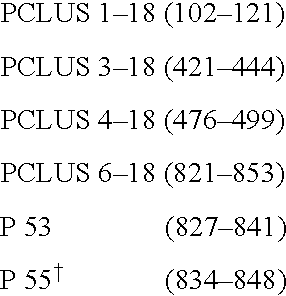Peptides which elicit a high neutralizing antibody titer, cytotoxic T lymphocyte response and T helper cell response in a broad range of MHC type recipients
- Summary
- Abstract
- Description
- Claims
- Application Information
AI Technical Summary
Benefits of technology
Problems solved by technology
Method used
Image
Examples
example i
Immunization of Mice to Produce High Titer Neutralizing Antibody Against HIV-1
[0045]The peptides of the present invention can be used to produce a high titer of AbN against a target antigen by immunization of a mammalian host with the peptide. In this Example, peptides derived from the sequence of the HIV-1 envelope glycoprotein gp 120 are used to elicit high titers of AbN in mice.
[0046]Immunizations. Mice were immunized intraperitoneally with 20 nanomoles of each peptide emulsified 1:1 in Freund's Complete Adjuvant (CFA). At days 21 and 31 post immunization blood was drawn by retroorbital bleed, allowed to clot and the serum removed and frozen at −20° C. Because antibody levels were found to still be rising between day 21 and day 31 after primary immunzation, the results from 31-day sera are reported. Selected groups of animals were boosted 36-52 weeks post primary immunization with 10 nanomoles of peptide in CFA intraperitoneally and bled 10-11 days later, when the secondary respo...
example ii
Immunization of Mice to Elicit CTL Against HIV-1
[0076]Since HIV can spread via cell to cell transmission, the ability to elicit a viral specific CTL response might be important for a synthetic peptide vaccine in order to be an effective modality of immunotherapy.
[0077]The peptides described in Example I contain a CTL epitope in addition to a Th epitope and PND. Thus, the peptides were also tested for induction of CTL activity in mice.
[0078]Here, we address the question with a single immunization using a saponin adjuvant, QS21 (103), which does not require an emulsion, allowing us to test the requirement for covalent linkage between helper and CTL epitopes under limiting conditions. We also addressed the MHC linkage of helper activity by using congenic mouse strains differing in class II MHC but sharing the H-2Dd class I molecule presenting the CTL determinant.
[0079]We have previously described the construction of synthetic peptides encompassing immunodominant Th peptides spanning mu...
example iii
Broad Immune Response Elicited by Cluster Peptides Attached to the P18 Peptide of HIV-1 Variant MN
[0093]The hypervariability of the V3 loop of the HIV-1 virus raises the concern that vaccines directed to particular amino acid sequences in this region might not provide protection against the broad assortment of strains to which individuals might be exposed. One approach to overcoming the problem of strain variation is to immunize an individual with a preparation which comprises a mixture of several peptides, each directed against a different strain of the target pathogen. In order to assess the efficacy of peptides of the present invention against additional strains of HIV-1, we prepared a series of cluster peptides attached to the P18 peptide derived from the V3 loop of the MN strain of HIV-1.
[0094]The peptides were prepared as described in the General Methods above. The sequences of the PCLUS-18 MN peptides are presented in Table VI (SEQ ID NOs:27-33).
[0095]a P18MN portion=RIHIGPGR...
PUM
| Property | Measurement | Unit |
|---|---|---|
| Fraction | aaaaa | aaaaa |
| Time | aaaaa | aaaaa |
| Time | aaaaa | aaaaa |
Abstract
Description
Claims
Application Information
 Login to View More
Login to View More - R&D
- Intellectual Property
- Life Sciences
- Materials
- Tech Scout
- Unparalleled Data Quality
- Higher Quality Content
- 60% Fewer Hallucinations
Browse by: Latest US Patents, China's latest patents, Technical Efficacy Thesaurus, Application Domain, Technology Topic, Popular Technical Reports.
© 2025 PatSnap. All rights reserved.Legal|Privacy policy|Modern Slavery Act Transparency Statement|Sitemap|About US| Contact US: help@patsnap.com



